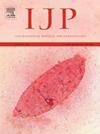Acanthamoeba castellanii trophozoites need oxygen for normal functioning and lipids are their preferred substrate, offering new possibilities for treatment
IF 3.2
2区 医学
Q1 PARASITOLOGY
引用次数: 0
Abstract
Acanthamoebae, pathogenic free-living amoebae, can cause Granulomatous Amoebic Encephalitis (GAE) and keratitis, and for both types of infection, no adequate treatment options are available. As the metabolism of pathogens is an attractive treatment target, we set out to examine the energy metabolism of Acanthamoeba castellanii and studied the aerobic and anaerobic capacities of the trophozoites. Under anaerobic conditions, or in the presence of inhibitors of the electron-transport chain, A. castellanii trophozoites became rounded, moved sluggishly and stopped multiplying. This demonstrates that oxygen and the respiratory chain are essential for movement and replication. Furthermore, the simultaneous activities of both terminal oxidases, cytochrome c oxidase and the plant-like alternative oxidase, are essential for normal functioning and replication. The inhibition of normal function caused by the inactivity of the respiratory chain was reversible. Once respiration was made possible again, the rounded, rather inactive amoebae formed acanthopodia within 4 h and resumed moving, feeding and multiplying. Experiments with radiolabelled nutrients revealed a preference for lipids over glucose and amino acids as food. Subsequent experiments showed that adding lipids to a standard culture medium of trophozoites strongly increased the growth rate. Acanthamoeba castellanii trophozoites have a strictly aerobic energy metabolism and β-oxidation of fatty acids, the Krebs cycle, and an aerobic electron-transport chain coupled to the ATP synthase, producing most of the used ATP. The preference for lipids can be exploited, as we show that three known inhibitors of lipid oxidation strongly inhibited the growth of A. castellanii. In particular, thioridazine and perhexiline showed potent effects in low micromolar concentrations. Therefore, this study revealed a new drug target with possibly new options to treat Acanthamoeba infections.

卡斯特拉氏棘阿米巴滋养体需要氧气才能正常运作,而脂质是它们的首选底物,这为治疗提供了新的可能性。
棘阿米巴虫是一种致病性自由生活阿米巴虫,可引起肉芽肿阿米巴脑炎(GAE)和角膜炎,对于这两种类型的感染,目前还没有适当的治疗方案。由于病原体的新陈代谢是一个有吸引力的治疗目标,我们开始研究卡斯特拉氏阿米巴原虫的能量代谢,并研究滋养体的需氧和厌氧能力。在厌氧条件下,或在存在电子传递链抑制剂的情况下,卡斯特拉氏棘阿米巴滋养体变得浑圆,运动迟缓并停止繁殖。这表明氧气和呼吸链对运动和复制至关重要。此外,细胞色素 c 氧化酶和植物样替代氧化酶这两种末端氧化酶的同时活动对正常功能和复制至关重要。呼吸链不活跃对正常功能的抑制是可逆的。一旦呼吸作用得以恢复,这些圆形的、相当不活跃的变形虫就会在 4 小时内形成棘足,并恢复运动、进食和繁殖。用放射性标记的营养物质进行的实验表明,阿米巴虫更喜欢脂类而不是葡萄糖和氨基酸作为食物。随后的实验表明,在滋养体的标准培养基中添加脂质可大大提高滋养体的生长速度。卡氏棘阿米巴滋养体具有严格的有氧能量代谢和脂肪酸的β-氧化、克雷布斯循环,以及与 ATP 合成酶耦合的有氧电子传递链,可产生大部分用过的 ATP。我们发现,三种已知的脂质氧化抑制剂都能强烈抑制卡斯特氏菌的生长。特别是,硫利达嗪和过氧苯胺在低微摩尔浓度下显示出了强效作用。因此,这项研究揭示了一个新的药物靶点,可能是治疗棘阿米巴感染的新选择。
本文章由计算机程序翻译,如有差异,请以英文原文为准。
求助全文
约1分钟内获得全文
求助全文
来源期刊
CiteScore
8.40
自引率
2.50%
发文量
76
审稿时长
23 days
期刊介绍:
International Journal for Parasitology offers authors the option to sponsor nonsubscriber access to their articles on Elsevier electronic publishing platforms. For more information please view our Sponsored Articles page. The International Journal for Parasitology publishes the results of original research in all aspects of basic and applied parasitology, including all the fields covered by its Specialist Editors, and ranging from parasites and host-parasite relationships of intrinsic biological interest to those of social and economic importance in human and veterinary medicine and agriculture.

 求助内容:
求助内容: 应助结果提醒方式:
应助结果提醒方式:


